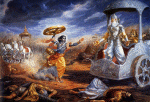
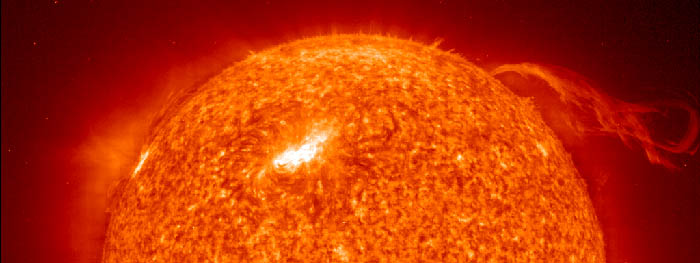
![]() Gayatri
Mantra is an adoration of the effulgence of the Sun.
Gayatri
Mantra is an adoration of the effulgence of the Sun.
Surya (Sun) is adored in the Vedas as Savitr, Pushan, Bhaga, Vivasvat, Mitra, Aryaman and Vishnu. These deities, Amsa, Daksha, Maartaanda are the Adityas. Savitr is 'the stimulator of everything' (sarvasya prasavitaa--Niruktam, 10,31). Vivasvat was the first sacrificer; in Avesta, Vivanhant was the first mortal who prepared Haoma (Vedic Soma). The Brahmanas and Puranas enumerate twelve Adityas: Dhaatr, Mitra, Aryaman, Rudra, Varuna, Surya, Bhaga, Vivasvan, Pushan, Savitaa, Tvashtaa and Vishnu. Surya is described as the soul of movable and immovable things (suurya aatmaa jagasatasthuushasca: RV. I.115,1).
Rigveda describes Surya as: divya suparna garutmaan (beautiful-winged celestial bird Garutmaan)(RV. VII, 77,3), as a white brilliant steed brought by Ushas. These descriptions result in the concept of Garuda as the mount of Vishnu. Surya is also endowed with a chariot drawn by horses: moving on a car drawn by one, by several or by sevaen fleet and ruddy horses (RV. I. 115, 3-4; VII.60,3; VII.63.2).
Anandagiri refers to six classes of sun-worshippers; all of them bore naamam (caste-mark) made of red sandal paste, wore garlands of red flowers and repeated the Suurya Gaayatrii of eight syllabes.
Samba reportedly built a temple for Surya at Muulasthaanapura (Multan, Pakistan) on the banks of Candrabhaagaa river. The temple is described in the writings of Hiuen Tsang and Arab geographers Al Edrisi and Abu Ishak al Ishtakhri. Puranas also refer to Saambaaditya installed at Mathura. Brhatsamhitaa refers to Magas (from Magi, the Mithra or Mihira-worshipping priests of Iran) who were entitled to install the images of Surya in temples (Ch. 59, V.19). Brhatsamhitaa describes that 'the god should be dressed in the fashion of a northerner, (his body) from the feet up to the breast being covered. He should wear a crown and hold two lotus flowers by their stalks. His face should be adorned with ear-rings, he should wear a long necklace...' (Ch. 57, 46-48).
Yajnavalkyasuutra (Bombay edition, 1892, p. 89) states that grahayajna should be performed by one who desired peace and prosperity, ample rains (for his crops), long life and nourishment, and (by him) who wants to harm his enemies; the figures of Surya, Soma (moon), the son of the earth (Mangala, Mars), the son of Soma (Budha, Mercury), Brhaspati (Juipter), Sukra (Venus), Sani (Saturn), Rahu and Ketu should be made of copper, crystal, red sandal (wood), gold (in the case of Budha and Brhaspati), silver, iron, lead and bell-metal respectively; or these figures should be drawn on canvas in their respective colours, or in the mandalas made of scented paste (sandal wood paste--these are of the lepajaa variety). This text and many other texts like Vishnudharmottara, Agnipuraana, Amsumadbhedaagama, Silparatna describe their forms... Stone slabs with these grahas are usually standing. (Jitendra Nath Banerjea, The Development of Hindu Iconography, Delhi, Munshiram Manoharlal, 1956, p. 443-444)
Surya, in Hindu mythology and religion, the sun and the sun god. Although in the Vedic period several other deities also possessed solar characteristics, most of these were merged into a single god in later Hinduism. Surya once ranked together with Vishnu, Shiva, Shakti, and Ganesha, and many temples dedicated to him are found throughout India. In modern Hinduism he is worshiped as the supreme deity by only a small following, the Saura sect, though he is invoked by all Hindus, and the Gayatri-mantra, uttered daily at dawn by orthodox Hindus, is addressed to the sun. Surya is the mythological father of many notable sons, including Manu (progenitor of the human race), Yama (lord of death), the Ashvins (twin physicians to the gods), Karna (a great warrior of the Mahabharata), and Sugriva (king of monkeys). The Puranas record that the weapons of the gods were forged from pieces trimmed from Surya, whose full emanation was too bright to bear. His power was conceived of as dispelling darkness, curing disease, and heating and illuminating the world. His wife Usas--in some accounts, his mother or mistress--is the personification of dawn. Sculptures of Surya often show him in "northern" or Scythian dress--close-fitting coat and high boots--suggesting an influence from Iranian sun cults. He is commonly represented in a chariot drawn by seven horses, or by a single horse with seven heads, holding full-blown lotuses, his head surrounded by a nimbus or by rays.
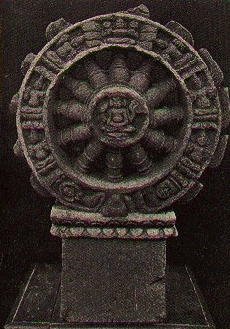 Navagraha
Cakra, Khiching, Orissa (ca. 10th cent. A.D.). The cakra has twelve spokes
and rests on its side on a lotus pedestal. Flames issue from the rim of
the wheel. The grahas are arranged inside the broad rim of the wheel. Surya
is seated in the top centre. Rahu and Ketu are on either side at the bottom.
On the sides are carved, one above the other, the six other grahas, three
on either side. In the centre of the wheel is a three-faced (?) four-armed
figure seated in padmaasana with its front hands in the dhyaana mudra;
the figure perhaps represents Brahma.
Navagraha
Cakra, Khiching, Orissa (ca. 10th cent. A.D.). The cakra has twelve spokes
and rests on its side on a lotus pedestal. Flames issue from the rim of
the wheel. The grahas are arranged inside the broad rim of the wheel. Surya
is seated in the top centre. Rahu and Ketu are on either side at the bottom.
On the sides are carved, one above the other, the six other grahas, three
on either side. In the centre of the wheel is a three-faced (?) four-armed
figure seated in padmaasana with its front hands in the dhyaana mudra;
the figure perhaps represents Brahma.
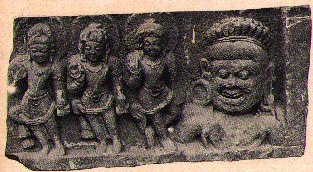 Four
grahas: Brhaspati, Sukra, Sani and Rahu, Sarnath (Sandstone fragment, Exhibit
No. 1536 in the Indian Museum). The fierce-looking Rahu is shown only up
to the breast, with a grinning face, round protruding eyes, hair tied up
in a bunch of spiral coils rising upwards. Rahu has his hands in tarpana
mudra. Brhaspati, Sukra and Sani have each a halo behind his head, and
a rosary in his right hand; the left hands of Brhaspati and Sukra hold
a water-pot. Sani's left hand is broken. The complete slab should have
contained eight grahas (excluding Ketu). In Bengal and Eastern Indian medieval
temples, only eight grahas are depicted (excluding Ketu). In one sculpture
in Ashutosh Museum, Calcutta, eight grahas are shown together with Ganesa
as the first deity.
Four
grahas: Brhaspati, Sukra, Sani and Rahu, Sarnath (Sandstone fragment, Exhibit
No. 1536 in the Indian Museum). The fierce-looking Rahu is shown only up
to the breast, with a grinning face, round protruding eyes, hair tied up
in a bunch of spiral coils rising upwards. Rahu has his hands in tarpana
mudra. Brhaspati, Sukra and Sani have each a halo behind his head, and
a rosary in his right hand; the left hands of Brhaspati and Sukra hold
a water-pot. Sani's left hand is broken. The complete slab should have
contained eight grahas (excluding Ketu). In Bengal and Eastern Indian medieval
temples, only eight grahas are depicted (excluding Ketu). In one sculpture
in Ashutosh Museum, Calcutta, eight grahas are shown together with Ganesa
as the first deity.
There are two temples for Surya in India; one is in Konarak (near Puri, Orissa) and the other is in Suryanarkovil (near Kumbakonam, Tamilnadu). Both the temples have been built by kings of the Cola lineage.
Suryanarkovil temple for Surya was constructed by Kulottunga Cola in 1113 A.D. An inscription in the temple states that the temple was built in the reigin of Kulottungacoladeva (1060-1118 A.D.) and was called Kulottungacola-Marttaandaalaya.
The Konarak temple was built 2 centuries later between 1238 and 1263 by Narasimha Coda(Cola?)ganga from the lineage of Kaaravela. Karunakara Tondaimaan conquered Kalinga in 1112 A.D. by defeating Anantaverma Codaganga. Kaaravela was perhaps a descendant of the Cola lineage. An original structure dating back to the 9th century once stood here.
Navagraha Temple at Guwahati in Assam dates to the 17th century. The temple is located on Chitrachal hill and was once a center for the study of astrology.
Sun Temple at Kandaha (Bangaon) near Saharsa,
Bihar
Sun Temple at Gaya, Bihar
Konarak
(A world heritage site)
One of the most splendid temples dedicated to
Surya is the Surya
Deula ("Sun Temple"), once called the Black Pagoda, at Konarak,
in Orissa, on the Bay of Bengal coast. There, the whole structure is conceived
as a chariot on wheels in which the sun god rides across the heavens pulled
by prancing horses. The Black Pagoda was used as a navigation landmark
by mariners sailing to Calcutta. Never completed and falling into ruins
before its restoration, the temple represents the culmination of the Orissan
school of temple architecture. In its original form, the deul was 235 feet
high and the jagamohana was about 150 feet high.
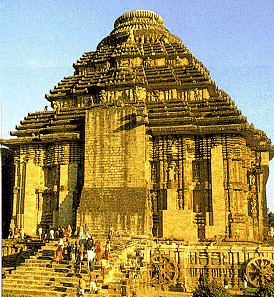
The temple was dedicated to the sun god Surya;
it was designed to represent his chariot, with 12 huge carved stone wheels
and 7 stone horses around its base. The Surya Deula is about
100 feet (30 m) high and would have surpassed 200 feet (60 m) in height
at its completion. The exterior is covered with sculptured decorations,
many depicting erotic scenes. Legends say that Samba, the son of Lord Krishna,
was afflicted by leprosy, brought about by his father's curse on him. After
12 years of penance, he was cured by Surya, the Sun God, in whose honour
he built this temple. 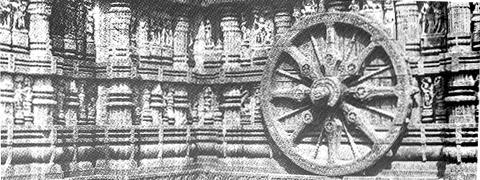
Wheel depicted on the Konarak Temple
Built by Raja Narsimhadeva of the Ganga dynasty, in the 13th century AD, the temple is a pageant of human grandeur, in its perception, and in the execution of even the finest details. It resembles a colossal chariot, with 24 wheels, pulled by seven straining horses, and has a three-tiered pyramidal roof topped off by a fine spire. The Sun - God's chariot, also represents the seven days of the week, and the 24 hours of the day, in its concept. The temple is a brilliant chronicle in stone, with impressive sculptures. Every aspect of life is represented here, and the erotic imagery, depicts the sublimation of human love manifested in countless forms. Scenes from court, civic life and war are also done with great precision.
Unlike the other temples of the Bhubaneswar-Konark-Puri region, the Konark temple had two smaller outer halls, completely separate from the main structure. The assembly-hall and the tower were built on an imposing platform, which were carved into meticulously crafted twelve pairs of decorated wheels, each 10 feet in diameter. The entrance is reached by a broad flight of steps, flanked on either side by prancing horses, the whole representing the chariot, in which the Sun-God rides across the heavens. The court of the temple, was decorated with large free-standing sculptures of great strength and beauty. Now protected under the World Heritage List, the temple's interior was filled - up in 1903 A.D., by the then British Lt. Governor of Bengal, to save it from deterioration.